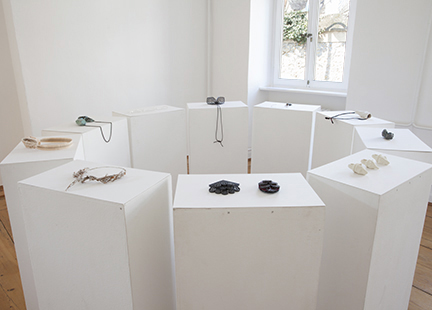With Otto Künzli’s much-deserved exhibition up at the Pinakothek der Moderne in Munich, Germany, it seems to be a good time to have a deeper look at his work as a professor as well as a maker. Five of his students—Alexander Blank, Attai Chen, Carina Chitsaz-Shoshtary, Melanie Isverding, and Mia Maljojoki have organized a show at the Galerie Rosemarie Jäger this month called Helter Skelter. Rather than discussing the theme of the show, I decided to ask these former students of Otto Künzli’s about his work as a teacher.
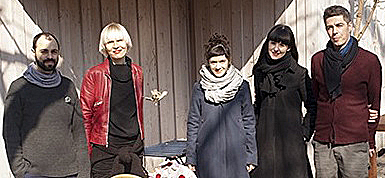
Susan Cummins: What is Professor Künzli’s secret sauce? How does he inspire his students to be ambitious and express their individual ideas? Please describe an occasion or two when Professor Künzli influenced you in a way that had a profound affect on your work and your life as an artist?

Normally, right after this warm greeting, the going starts to get very rough, and for me it was no different. I was quickly lost, finding it difficult to orientate myself! The Academy of Fine Arts offers a very open structure. Actually, one might say no structure as compared to what one finds in the other fine art courses. You are only given a place to work and the time to be to face your demons. That is the great freedom and the trap! One must learn to get used to it or move on to something else. The results became my own responsibility. I could sleep for six years if I wanted to, or I could make some jewelry. I could decide for myself that jewelry sucks. That time of confusion and disorientation was very important. I realized then that if I am not doing what I want to do, no one else will do it for me. I understood that, sooner or later, I had better start working.
One very good thing for me was the community of my friends and colleagues, Otto included. He always had an open ear to listen and would always share an opinion if I needed one. He had much input to offer not only from jewelry, but also from various fields and life in general. There was a lot of critique offered about my work and on other students’ work. In these discussions, I was able to find my own position, pro or against, but I never felt I had to follow a “correct” opinion. Discussions about jewelry and other interesting topics were constantly occurring somewhere in the academy, which was a good place to learn how to distinguish between different qualities. It was never only the positive things I had to deal with, the easier lessons, but the difficult ones as well. These harder ones belong just as much to professional life. Being confronted with ups and downs in different situations is 100-percent real, and one has to arrange oneself with that. That´s how the game runs, and I love that game! It has not become boring yet.
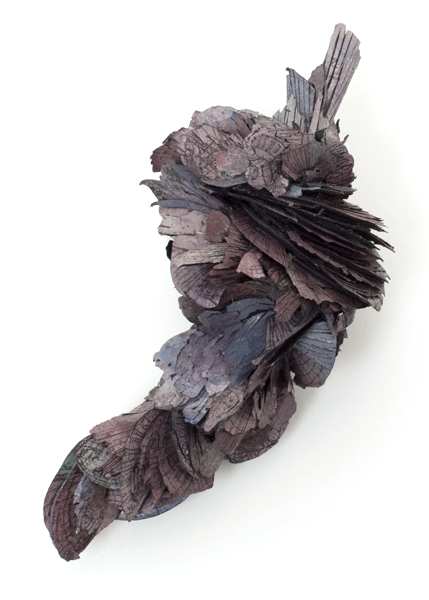
I think that Otto chooses his students with a very careful eye. As I wrote before, he has sharp eyes. In most cases, he understands the type of the person in front of him very quickly and his or her potential. I think he chooses students mainly by their character and by their earnest desire to devote themselves their work. In general, I don’t necessarily think he chooses his students by their brilliant talent or technique.
Otto’s class is a bit like a Zen monastery. Most of the people that come to study with him have already studied and worked as jewelers. They are mainly between 25 and 30 years old, and they know that they have to leave their previous lives behind and obligate themselves to five to six years of studying. There is almost no guidance. No tasks or exercises are given. It is mainly you, in front of yourself, in front of the working bench with a big shadow of perfectionism floating above you. It is scary and more challenging than any training I had before. In the first year you are in a bit of a shock, but if you pass this test, then there might be a chance you will evolve into an independent artist. Otto says that he is “throwing” us into the water, and that we should find our own way to swim. If we begin to drown, he might be there to give us a hand and help us pull ourselves out. I think this is one of the main reasons you see such a large variety of work among his students. But when he is working with us or when we are working on a class project (annual exhibitions), it has to be perfectly planned with no shortcuts, with extreme precision, and down to the smallest detail. This was the first time in my life that I met such a high level of demanding.
I can say that I learned the most from Otto on the occasions that we worked together with him on an exhibition. It was very inspiring to see how he is aware of every detail. He almost gives the same attention to the smallest details as to the most important ones. Being this specific can relate to the production of an exhibition, to the back mechanism of a brooch, or the knot end of a pendant string. Everything has to be exactly as it should be, even if no one else will see it.
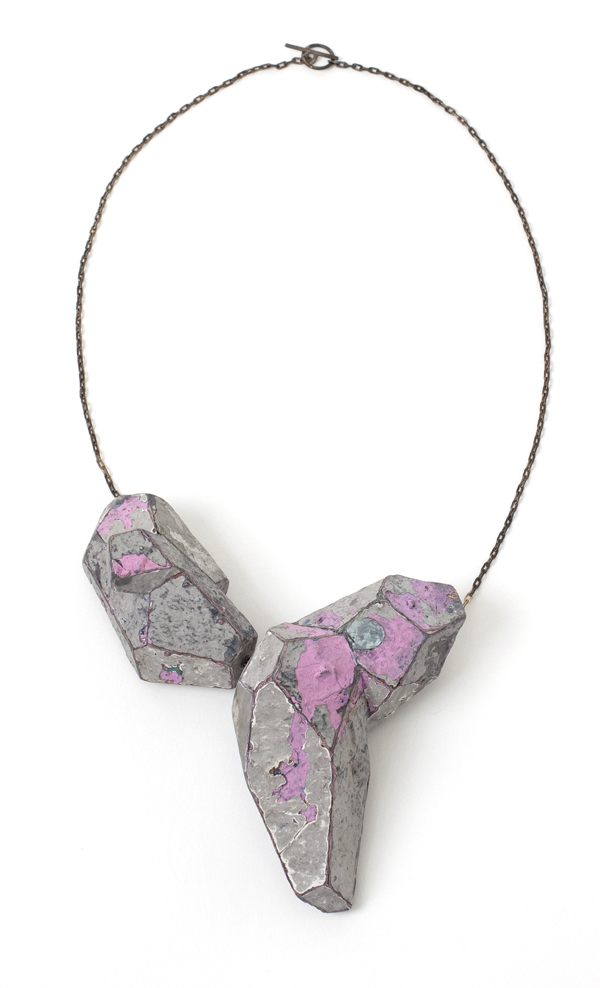
It is not simple to explain Otto’s ways of inspiring. Mostly, in the beginning, I felt like I was drowning. Otto normally does not interfere, he observes. You can always talk with him about your work, but first you should have something to talk about, no? This leaves you with all the freedom you could wish for, but it is that freedom you will curse soon enough. It took me three years to develop my first pieces, but then making jewelry came quite naturally to me from one day to the next. I had learned to swim, I guess. We have the time and the room to go through all the phases of developing our art—the sweet fun and sun times when you are kissed by a muse and the long moments of sitting hopelessly lost in the darkest deepest hole. I think we all have been there. There are no short cuts.
And Otto, well, he is not only observing us. We observe him, too. After five to six years, if no spark leaps over, you might be a lost case.
My first conversation with Otto instantly and entirely changed my perspective on making jewelry. I came for an interview with Otto before applying to the jewelry class in Munich. I must admit that my knowledge about contemporary jewelry was rather poor. I had finished my apprenticeship as a goldsmith only a year before. I showed Otto some sketchbooks with drawings of pieces I was planning to build in metal, but he was missing tests or sketches made from actual material. I told him I didn´t have a workshop yet, and therefore I could not use my goldsmith tools. He smiled and answered that I would not need goldsmith tools or a workshop or even metal to make jewelry. I could try out any material I found and use everything as a tool. Any table would do, too. “Just choose something and start playing,” he said.
In the following weeks, I collected large quantities of different materials and began to experiment with them. First it was only fun, but then it turned into a fever. I was cutting, gluing, sewing, melting, and burning day and night. I must say I never was really made for metal. The tediousness of the working process and the rigidity of the material never appealed to me. But then a whole world of potential materials was offered to me! I felt so excited! Since then, I have never returned to metal. And the search for extraordinary materials is a dominant element in my work.
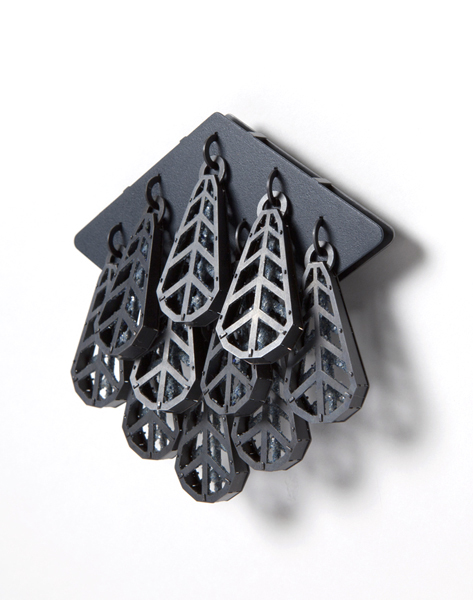
In the beginning, our weekly class meetings were the only things I could hold on to. Every week, we discussed work from a different student, and I listened carefully to every word that was spoken from Otto and from my colleagues. But there was nothing I really understood. There was no right or wrong, no parameters I could follow, just a feeling. After a while, I started my own jewelry projects again, but I was still very insecure. I did not know what to do, what to want, where to go. I was always questioning my position. The wall I stared at in the beginning was not an enemy any more, not a mirror that showed my undefined face. It was slowly filled with loads of different things—stories, talks, experiences, ups and downs, and failures. Slowly, it began to show a map in which I could navigate again.
Otto is a person who accompanies his students but never guides them. He is critical and constructive, yet at the same time he leaves you as you are without pushing you in a certain direction. He sees his students as colleagues at eye level. He is always there to talk, discuss, or share a moment.
After six years of studying, I still can´t tell how he influenced me in my way of working. It is very difficult to find words for that. Yet, I can tell that he gave me a feeling of trust in what I was doing. That trust gave me the strength and experience to develop my own way of working and thinking. I learned to have a critical and constructive view of my work and my surroundings. So, something must have happened in that time, and I definitely know that the academy was the right place for me to study.
The class was invited to install a one-day exhibition for Koninginnedag (Queen’s Day) for the consulate general of The Netherlands at the Pinakothek der Moderne in Munich. Because Otto was going to be out of town, he asked the class for volunteers to be in charge of the organization and realization of this exhibition. The concept for the exhibition had already been discussed and was clear. So finally, two of my colleagues and I received this responsibility. We had to coordinate with the museum, find a graphic designer and printer for an invitation and banners, and we had to organize the student jewelry from our class and from the class of the Gerrit Rietveld Academie in Amsterdam. So, the whole thing was quite a complex project. I felt very challenged to carry the responsibility to represent of our class from Munich, to represent the class from Amsterdam, but most importantly, to represent Otto Künzli.

When one arrives, Otto offers you a bench to work at and all the time and all the freedom in the world. The bench is simple and practical. The freedom is fascinating and crushingly overwhelming.
At first I watched, I listened, I tasted, I smelled, and I touched. The full spectrum of emotions raged with me—despair, excitement, anger, happiness, frustration, tranquility, uncertainty, love, and most often, madness. Rather than finding answers, I ended up with more questions. The ground slowly fell away under me. I was alone, wandering through the darkness. I ended in a space where I could see no windows to peer out of and no door to escape through—the place where Otto guides all his students. Only then, in the dark, did I begin to speak. Actually, one might say I began to scream.
After about three years, I found myself in tears while sitting in Otto’s office and discussing my position as an artist with him. As always, Otto offered no solutions nor did he suggest any direction in which I should push my work. He simply asked me how he could help. He asked for my own suggestions and my own ideas. He showed me respect and showed me that I was worth respecting. The ideas had to come from me and only me. I had to make each decision every step of the way.
Otto Künzli is a great artist and a greater educator. He created a place that allows one to find their way. He gives nothing, he teaches even less, yet what he offers transforms the willing into artists.
